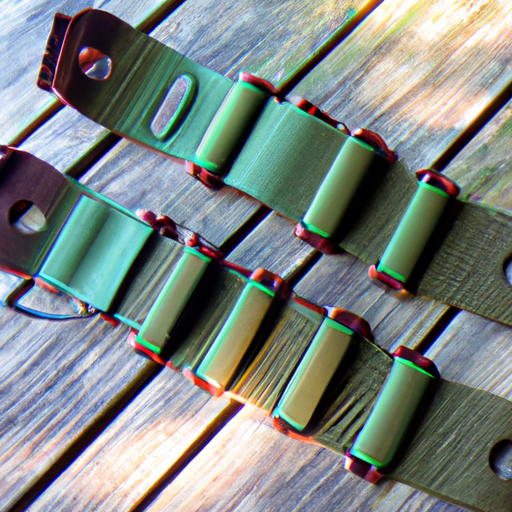“Choose the right sling for your rifle: single-point for maneuverability, two-point for stability.”
Benefits of Using a Single-Point Sling for Your Rifle
When it comes to choosing a sling for your rifle, there are a few key factors to consider. One of the main decisions you’ll need to make is whether to go with a single-point sling or a two-point sling. Both options have their own advantages and disadvantages, so it’s important to weigh the pros and cons before making a decision.
Let’s start by taking a closer look at single-point slings. One of the biggest benefits of using a single-point sling is that it allows for maximum maneuverability. With a single-point sling, your rifle hangs directly in front of you, allowing you to quickly bring it up to your shoulder and aim without any restrictions. This can be especially useful in close-quarters combat situations where speed and agility are crucial.
Another advantage of single-point slings is that they are easy to adjust. Most single-point slings feature a simple clip or buckle that allows you to quickly adjust the length of the sling to fit your body and shooting style. This makes it easy to switch between different shooting positions or transition between your rifle and sidearm.
Single-point slings are also popular among shooters who prefer a more minimalist setup. Since single-point slings attach directly to the back of the rifle, there is less material and hardware involved, making for a sleeker and more streamlined look. This can be especially appealing for shooters who value simplicity and efficiency in their gear.
In addition, single-point slings can be quickly detached from the rifle, allowing for easy transitions between carrying your rifle on your shoulder and stowing it away when not in use. This can be particularly useful for hunters or outdoor enthusiasts who need to keep their hands free while navigating rough terrain.
However, it’s important to note that single-point slings do have some drawbacks. One of the main concerns with single-point slings is that they can cause fatigue over time, especially if you’re carrying a heavy rifle for an extended period. Since the weight of the rifle is concentrated on one point on your body, it can put strain on your neck and shoulders, leading to discomfort or even injury.
Another potential downside of single-point slings is that they can allow your rifle to swing freely when not in use, potentially hitting objects or getting tangled in brush. This can be mitigated by using a retention device or simply being mindful of how you move with your rifle slung over your shoulder.
In conclusion, single-point slings offer several benefits for shooters looking for maximum maneuverability, quick adjustments, and a minimalist setup. However, it’s important to consider the potential drawbacks as well, such as fatigue and the risk of accidental swinging. Ultimately, the best sling for your rifle will depend on your individual preferences and shooting style.
Advantages of Using a Two-Point Sling for Your Rifle
If you are a rifle owner, you know the importance of having a reliable sling to help carry and stabilize your weapon. There are many options available on the market, but two of the most popular choices are single-point slings and two-point slings. In this article, we will discuss the advantages of using a two-point sling for your rifle.
One of the main benefits of a two-point sling is its versatility. Unlike single-point slings, which only attach to the rear of the rifle, two-point slings can be attached to both the front and rear of the weapon. This allows for better weight distribution and stability when carrying your rifle for extended periods of time.
Additionally, two-point slings offer more options for adjusting the length of the sling to fit your body and shooting style. This customization can make a big difference in comfort and ease of use when carrying your rifle in different situations.
Another advantage of using a two-point sling is that it allows for easier transitions between different shooting positions. With a single-point sling, the rifle tends to swing freely and can get in the way when moving from standing to kneeling or prone positions. A two-point sling helps keep the rifle close to your body and out of the way, making it easier to maneuver in tight spaces.
Furthermore, two-point slings provide better stability when shooting from unsupported positions. By attaching the front of the sling to a handguard or rail system, you can create tension that helps stabilize the rifle when aiming and firing. This added support can make a big difference in accuracy and shot placement, especially in high-pressure situations.
In addition to these practical advantages, two-point slings also offer increased safety benefits compared to single-point slings. With two attachment points, there is less risk of accidentally dropping or losing control of your rifle while moving or transitioning between shooting positions. This added security can give you peace of mind knowing that your weapon is securely attached to your body at all times.
Overall, using a two-point sling for your rifle offers many advantages over single-point slings in terms of versatility, adjustability, stability, and safety. Whether you are a seasoned shooter or just getting started with firearms, investing in a high-quality two-point sling can greatly improve your shooting experience and overall performance on the range or in the field.
In conclusion, if you are looking for a reliable and versatile option for carrying and stabilizing your rifle, consider using a two-point sling. With its many advantages over single-point slings, such as better weight distribution, customization options, improved stability during shooting, and increased safety features, a two-point sling is an excellent choice for any rifle owner. Invest in a quality two-point sling today and experience the difference it can make in your shooting experience.
How to Properly Attach and Adjust a Single-Point Sling

When it comes to carrying your rifle, having the right sling can make all the difference in terms of comfort and ease of use. Two popular options are single-point and two-point slings, each with their own advantages and disadvantages. In this article, we will focus on single-point slings and how to properly attach and adjust them for optimal performance.
Single-point slings are characterized by their simplicity and ease of use. They attach to the rifle at a single point, usually near the rear of the receiver or stock. This allows the rifle to hang freely from your body, making it easy to quickly bring the weapon into a shooting position. Single-point slings are also great for transitioning between shoulders or carrying your rifle in a ready position.
To properly attach a single-point sling to your rifle, start by finding the attachment point on your weapon. This is typically located near the rear of the receiver or stock, but may vary depending on the specific model of rifle you have. Once you have located the attachment point, simply clip the sling onto it using the provided hook or attachment mechanism.
After attaching the sling to your rifle, it’s important to adjust it for optimal comfort and functionality. Start by adjusting the length of the sling so that it hangs comfortably from your body when in a shooting position. You want the rifle to be close enough to your body that you can easily bring it up to aim, but not so tight that it restricts your movement.
Once you have adjusted the length of the sling, make sure that it is properly secured to your body. This may involve adjusting a buckle or strap on the sling itself, or simply tightening up any slack in the material. The goal is to have the rifle securely attached to your body so that it doesn’t swing around or bounce as you move.
When using a single-point sling, it’s important to practice proper safety techniques. Always keep your finger off the trigger until you are ready to shoot, and never point your weapon at anything you don’t intend to shoot. Additionally, be mindful of where the muzzle of your rifle is pointing at all times, especially when moving through tight spaces or around other people.
In conclusion, single-point slings offer a simple and effective way to carry your rifle while keeping it easily accessible for shooting. By properly attaching and adjusting your sling, you can ensure that your weapon is secure and comfortable to carry. Remember to always practice good safety habits when using a single-point sling, and enjoy the convenience and versatility that this type of sling offers for carrying your rifle.
How to Properly Attach and Adjust a Two-Point Sling
When it comes to rifle slings, there are a variety of options available on the market. Two of the most popular choices are single-point slings and two-point slings. Both types have their own unique benefits and drawbacks, so it’s important to understand how each one works before making a decision.
One of the main differences between single-point and two-point slings is how they attach to the rifle. Single-point slings attach to the rifle at a single point, usually near the rear of the receiver. This allows the rifle to hang freely from the sling, making it easy to transition between shooting positions quickly. However, single-point slings can cause the rifle to swing around when not in use, which can be inconvenient and potentially dangerous.
On the other hand, two-point slings attach to the rifle at two points – typically near the front and rear of the rifle. This helps distribute the weight of the rifle more evenly across your body, making it more comfortable to carry for extended periods of time. Two-point slings also provide more stability when shooting from a prone position, as they help support the weight of the rifle.
To properly attach a two-point sling to your rifle, start by attaching one end of the sling to the front sling swivel on your rifle. This is usually located near the front of the handguard or barrel. Next, attach the other end of the sling to the rear sling swivel on your rifle. This is typically located near the rear of the stock or receiver.
Once both ends of the sling are attached, adjust the length of the sling to ensure a comfortable fit. You want the rifle to hang close to your body without being too tight or too loose. Most two-point slings have adjustable straps that allow you to easily change the length of the sling to fit your body size and shooting style.
When adjusting a two-point sling, make sure that it is positioned correctly on your body. The front attachment point should be near your dominant hand for easy access when transitioning between shooting positions. The rear attachment point should be positioned so that the rifle hangs comfortably on your back when not in use.
It’s also important to practice using your two-point sling before taking it out into the field. Practice adjusting the length of the sling quickly and efficiently so that you can make adjustments on-the-fly during a shooting situation. Familiarize yourself with how to properly shoulder your rifle with a two-point sling attached so that you can quickly bring it up to aim when needed.
In conclusion, two-point slings offer many advantages over single-point slings when it comes to carrying and shooting with a rifle. By properly attaching and adjusting a two-point sling, you can improve your shooting accuracy and comfort while out in the field. Practice using your two-point sling regularly so that you can quickly and effectively use it in any shooting situation.
Comparing Comfort, Stability, and Maneuverability Between Single-Point and Two-Point Slings
When it comes to choosing the best sling for your rifle, there are several factors to consider, including comfort, stability, and maneuverability. Two of the most popular options on the market are single-point slings and two-point slings. Each type has its own set of advantages and disadvantages, so it’s important to weigh the pros and cons before making a decision.
Let’s start by looking at single-point slings. These slings attach to the rear of the rifle and hang down in front of the shooter, allowing for quick and easy transitions between shoulders. Single-point slings are popular among tactical shooters who need to move quickly and maintain a high level of mobility. They offer a wide range of motion and allow for rapid target acquisition.
However, single-point slings can be less comfortable than two-point slings, especially during long periods of use. The weight of the rifle is concentrated on a single point on the shooter’s body, which can cause discomfort and fatigue over time. Additionally, single-point slings do not provide as much stability as two-point slings, which can make it more difficult to maintain a steady aim.
On the other hand, two-point slings offer a more stable platform for your rifle. These slings attach to both the front and rear of the rifle, distributing the weight evenly across your body. This can help reduce fatigue during extended shooting sessions and provide better support for heavier rifles.
Two-point slings also offer more versatility than single-point slings. They can be adjusted to different lengths to accommodate different shooting positions and preferences. Additionally, two-point slings can be used to carry your rifle in a hands-free manner when not in use.
One potential downside of two-point slings is that they can be slower to transition between shoulders compared to single-point slings. This could be a drawback for shooters who need to move quickly in dynamic shooting situations. However, with practice and proper technique, this issue can be minimized.
In terms of maneuverability, single-point slings have an edge over two-point slings. The design of single-point slings allows for greater freedom of movement when transitioning between shooting positions or engaging targets from different angles. This can be crucial in fast-paced shooting scenarios where every second counts.
Ultimately, the choice between a single-point sling and a two-point sling comes down to personal preference and intended use. If you prioritize mobility and quick transitions between shoulders, a single-point sling may be the best option for you. On the other hand, if stability and comfort are more important to you, a two-point sling might be the better choice.
Regardless of which type of sling you choose, it’s important to practice with it regularly to ensure that you are comfortable and proficient with its use. Proper training and technique can make all the difference when it comes to effectively utilizing your sling in real-world shooting situations.
In conclusion, both single-point and two-point slings have their own set of advantages and disadvantages when it comes to comfort, stability, and maneuverability. By carefully considering your needs and preferences, you can make an informed decision about which type of sling is best suited for your rifle setup.




